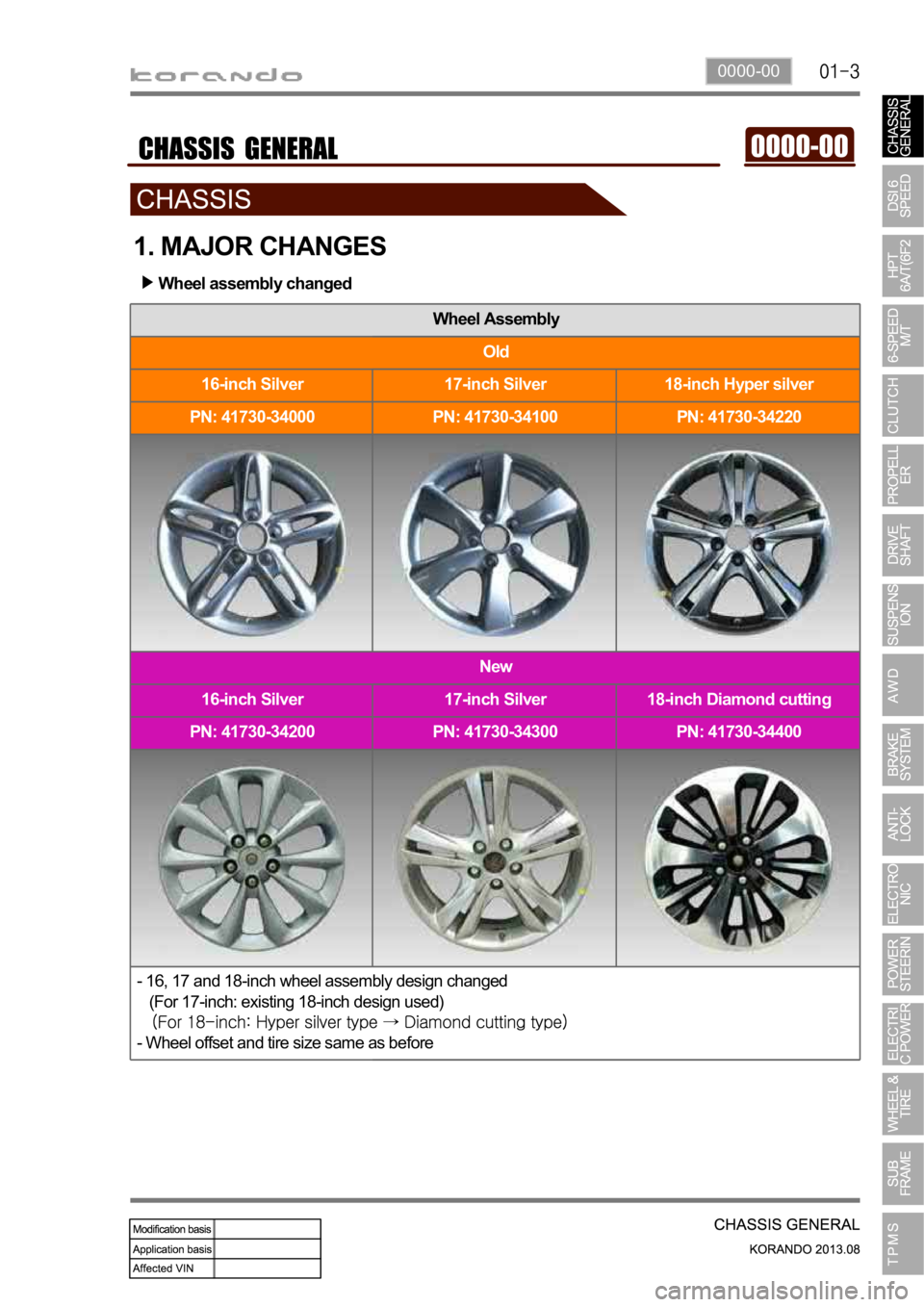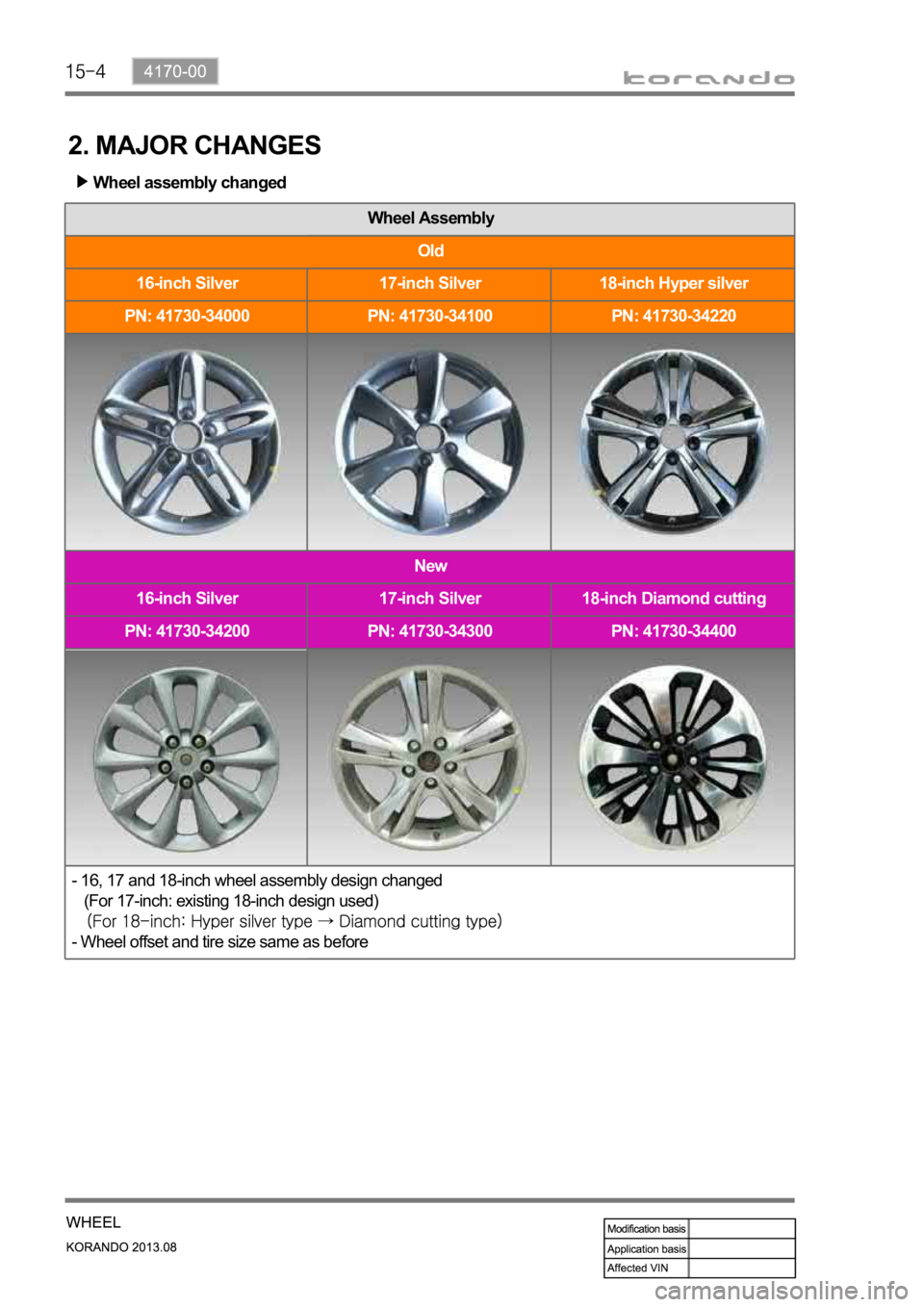tire size SSANGYONG KORANDO 2013 Service Manual
[x] Cancel search | Manufacturer: SSANGYONG, Model Year: 2013, Model line: KORANDO, Model: SSANGYONG KORANDO 2013Pages: 1336, PDF Size: 92.18 MB
Page 431 of 1336

Description Selection Coding
MIL MIL - not illuminate Select : MIL - illuminate
MIL - illuminate
Engine fan Relay Select : Relay
PWM
Air-Conditionation Not equipped Select the appropriate system
Equipped
OBD Information No MIL OBD - I Select the appropriate system
MIL treatment OBD - I
MIL treatment OBD - II
MIL treatment E - OBD
MIL treatment KOBD
Engine E20 Select : E20
E23
E28
E32
E36
Body Sedan Select : Sedan
Limousine
4. CODING
1) Variant Coding
Description Selection Coding
Unleaded/leaded Unleaded Select the appropriate system
Leaded
Cruise control No system Select the appropriate system
Cruise control
ACC
Undefined
Vehicle speed Max 180kph Selec : 190kph
190kph
200kph
210kph
Tire size 215/65R 16 Select the appropriate system
225/60R 17
225/55R 18
undefined
Page 981 of 1336

0000-00
Wheel assembly changed
Wheel Assembly
Old
16-inch Silver 17-inch Silver 18-inch Hyper silver
PN: 41730-34000 PN: 41730-34100 PN: 41730-34220
New
16-inch Silver 17-inch Silver 18-inch Diamond cutting
PN: 41730-34200 PN: 41730-34300 PN: 41730-34400
- 16, 17 and 18-inch wheel assembly design changed
(For 17-inch: existing 18-inch design used)
- Wheel offset and tire size same as before
1. MAJOR CHANGES
Page 1156 of 1336

Wheel assembly changed
Wheel Assembly
Old
16-inch Silver 17-inch Silver 18-inch Hyper silver
PN: 41730-34000 PN: 41730-34100 PN: 41730-34220
New
16-inch Silver 17-inch Silver 18-inch Diamond cutting
PN: 41730-34200 PN: 41730-34300 PN: 41730-34400
- 16, 17 and 18-inch wheel assembly design changed
(For 17-inch: existing 18-inch design used)
- Wheel offset and tire size same as before
2. MAJOR CHANGES
Page 1162 of 1336

If weight is not equally distributed around the wheel, unbalance centrifugal force by the wheel rotation
produces vibration. As the centrifugal force is produced proportional to the square of the rotating speed,
the wheel weight should be balanced even at high speed. There are two types of the tire and wheel
balancing: static and dynamic. Abnormal vibration may also occur due to unbalanced rigidity or size of
tires.
1) Static Balance
When the free rotation of the wheel is
allowed, the heavier part is stopped on the
bottom if the wheel weight is unbalanced and
this is called "Static Unbalance". Also, the
state at which tire's stop position is not same
is called "Static Balance" when the wheel is
rotated again. If the part A is heavier as
shown in the figure 1, add the balance weight
of a weight corresponding to unbalanced
weight from B to A to maintain the static
balance. If the static balance is not
maintained, tramping, up and down vibration
of the wheels, occurs.
2) Dynamic Balance
The static unbalance of the wheel creates
the vibration in the vertical direction, but the
dynamic unbalance creates the vibration in
the lateral direction. As shown in the figure
2 (a), if two parts, (2) and (3), are heavier
when the wheels are under the static
balance condition, dynamic unbalance is
created, resulting in shimmy, left and right
vibration of the wheels, and the torque Fxa
is applied in the axial direction. To correct
the dynamic unbalance, add the balance
weight of a same weight for two points of
the circumference of the rim, A and B, as
shown in the figure 2 (b), and apply the
torque in the opposite direction to the
torque Fxa to offset in order to ensure
smooth rotation of the wheel.
Center
A
B
a
a
Fxa
Fxa F
F
A
B
(a)(b)
[Figure 1]
[Figure 2]
3. WHEEL BALANCE